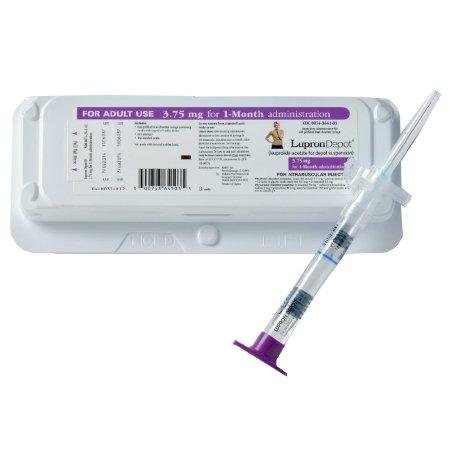Leuprolide Disease Interactions
There are 5 disease interactions with leuprolide.
GnRH agonists (applies to leuprolide) cardiovascular disease
Moderate Potential Hazard, Moderate plausibility.
Increased risk of developing myocardial infarction, sudden cardiac death and stroke has been reported in association with the use of GnRH agonists such as leuprolide, and triptorelin. Cardiovascular risk factors should be evaluated carefully before treatment initiation. Patients should be monitored for symptoms and signs suggestive of development or cardiovascular disease and should be managed according to current clinical practice.
References
- "Product Information. Lupron (leuprolide)." TAP Pharmaceuticals Inc PROD (2002):
- "Product Information. Trelstar (triptorelin)." Pharmacia and Upjohn PROD (2001):
- "Product Information. Eligard (leuprolide)." Sanofi Winthrop Pharmaceuticals (2002):
GnRH agonists (applies to leuprolide) diabetes
Moderate Potential Hazard, Moderate plausibility. Applicable conditions: Diabetes Mellitus
Hyperglycemia and an increased risk of developing diabetes have been reported in men receiving GnRH agonists such as leuprolide and triptorelin. Caution is advised in patients with diabetes as treatment with these agents may risk glycemic control. Monitor blood glucose and/or HbA1c periodically in patients receiving treatment.
References
- "Product Information. Trelstar (triptorelin)." Pharmacia and Upjohn PROD (2001):
- "Product Information. Eligard (leuprolide)." Sanofi Winthrop Pharmaceuticals (2002):
Leuprolide (applies to leuprolide) QT interval prolongation
Moderate Potential Hazard, Moderate plausibility. Applicable conditions: Long QT Syndrome, Congestive Heart Failure, Electrolyte Abnormalities
Androgen deprivation therapy may prolong the QT/QTc interval. Health care providers should consider if benefits of therapy outweigh the potential risks in patients with congenital long QT syndrome, congestive heart failure, electrolyte abnormalities, or taking other drugs that can also prolong the QT interval. Consider periodic monitoring of EKG and electrolytes.
References
- "Product Information. Lupron (leuprolide)." TAP Pharmaceuticals Inc PROD (2002):
- "Product Information. Eligard (leuprolide)." Sanofi Winthrop Pharmaceuticals (2002):
Leuprolide (applies to leuprolide) bone mineral density
Moderate Potential Hazard, Moderate plausibility. Applicable conditions: Osteoporosis
Decreased bone density has been reported in men who have had orchiectomy or who have been treated with a GnRH agonist analog as leuprolide. It can be anticipated that long periods of medical castration in men will have effects on bone density. Bone density loss may not be reversible. Therapy with leuprolide should be administered cautiously in patients with major risk factors for decreased bone mineral content, such as chronic alcohol and/or tobacco use, a strong family history of osteoporosis, or chronic use of drugs that can reduce bone mass (e.g., anticonvulsants, corticosteroids). Therapy beyond six months with gonadotropin-releasing hormone analogs is not recommended for patients with major risk factors for decreased bone mineral content.
References
- "Product Information. Lupron (leuprolide)." TAP Pharmaceuticals Inc PROD (2002):
Leuprolide (applies to leuprolide) seizures
Moderate Potential Hazard, Moderate plausibility.
Convulsions have been observed in patients taking leuprolide, including patients who have a history of seizures, epilepsy, or brain disorders, and in those taking medications associated with convulsions. Convulsions have also been reported in patients without any of these conditions. Caution is advised in patients with a history of seizures.
References
- "Product Information. Lupron (leuprolide)." TAP Pharmaceuticals Inc PROD (2002):
- "Product Information. Eligard (leuprolide)." Sanofi Winthrop Pharmaceuticals (2002):
Leuprolide drug interactions
There are 278 drug interactions with leuprolide.
More about leuprolide
- leuprolide consumer information
- Check interactions
- Compare alternatives
- Pricing & coupons
- Reviews (372)
- Side effects
- Dosage information
- During pregnancy
- Drug class: gonadotropin releasing hormones
- En español
Related treatment guides
Drug Interaction Classification
| Highly clinically significant. Avoid combinations; the risk of the interaction outweighs the benefit. | |
| Moderately clinically significant. Usually avoid combinations; use it only under special circumstances. | |
| Minimally clinically significant. Minimize risk; assess risk and consider an alternative drug, take steps to circumvent the interaction risk and/or institute a monitoring plan. | |
| No interaction information available. |
Further information
Always consult your healthcare provider to ensure the information displayed on this page applies to your personal circumstances.


